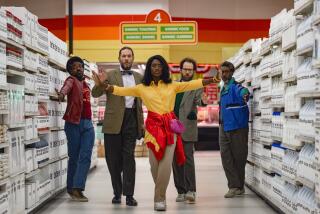Walking Piano Puts ‘Big’s’ Best Feat Forward
- Share via
Writers Gary Ross and Anne Spielberg popped into New York’s F.A.O. Schwarz one afternoon to research children’s tastes for their screenplay “Big.” Among the 40,000 square feet of toys, they noticed an electronic toy piano that enables a child to pick out a tune by jumping on the right keys.
It was a lucky find. This summer “Big” is a hit, so far grossing more than $60 million at the box office, and that Walking Piano is the center of the season’s most popular dance scene. Midway through the comedy, when Josh Baskin and his boss, “Mac” MacMillan, peck out “Heart and Soul” and “Chopsticks,” audiences invariably burst into applause.
The scene looks like a sure bet for the next version of “That’s Entertainment.” Some movie buffs are even talking about it in the same breath as Gene Kelly singing in the rain or James Cagney tap-dancing down the steps of the White House in “Yankee Doodle Dandy.”
That may be going too far. But there’s no doubt about the scene’s popularity this summer: It has created a new toy craze with adults, children and adults who wish they were children.
A spokeswoman for F.A.O. Schwarz says that since the movie arrived in theaters, customers have flocked to the store in search of the 7-foot-long piano, which sells for $6,250. Neiman-Marcus is offering a different version of the piano in its Christmas catalogue for $3,500. And gyms are calling the manufacturer, placing orders for their aerobics classes.
All of which is surprising but welcome news for the piano’s Italian inventor, Remo Saraceni, whose Philadelphia firm, Techno Future, specializes in “products for the future.”
Techno Future is manufacturing about 2,000 7-foot, one-octave pianos for Neiman Marcus. In addition, the firm is producing about 200 16-foot pianos with two-octaves--the same version that appeared in “Big.” Those pianos sell for $15,000 each.
“I believe in interactive technology,” says Saraceni. He adds that he built the piano seven years ago as a cheery form of social interaction. “It creates positive energy all around,” he says. “This is very important.”
Ross and Spielberg didn’t use the piano in their first drafts of “Big,” a 20th Century Fox film directed by Penny Marshall. Later, though, it became apparent that the writers needed a way for Josh Baskin--the 12-year-old who suddenly finds himself transformed into a 35-year-old man (Tom Hanks)--to forge an intimate friendship with his new boss, the chief executive of a toy company (MacMillan, played by Robert Loggia).
“The scene was born out of a need for Josh to hook up with MacMillan and establish a rapport,” says screenwriter Ross. The scene is popular, Ross believes, because “it is a perfectly plausible dance number” in a film that is straight comedy, not a musical.
Saraceni customized the walking piano for the film--adding a second octave and expanding it from 7 to 16 feet. But the piano grew so large that Timothy Bourne, an assistant production manager on the film, didn’t think Hanks and Loggia could stretch their legs far enough to play a melody.
“At first no one was sure if it was humanly possible to play ‘Heart and Soul,’ ” Bourne recalls.
So they made a cardboard cut-out of the piano for Hanks and Loggia to practice on. Loggia set that cutout in his back yard, next to the pool and practiced with the help of a cassette tape. “I’m no Gene Kelly,” says Loggia, “but I do like to do the jitterbug.”
Loggia is amused by the popularity of the dance scene because neither he nor Hanks is, as he says, “hoofers.” Hanks and Loggia were coached by choreographer Patricia Birch.
During the filming of the scene--at F.A.O. Schwarz in New York--two professional dancers were waiting in the wings, ready to provide close-up scenes of dancing feet. Marshall never had to call on them.
Loggia, who has made his mark on the screen playing not-so-nice guys in films like “Prizzi’s Honor” and “Jagged Edge,” sees the dance scene a much-needed change in his screen image. “People would rather remember you as a nice guy than a mean guy,” he says.
More to Read
The biggest entertainment stories
Get our big stories about Hollywood, film, television, music, arts, culture and more right in your inbox as soon as they publish.
You may occasionally receive promotional content from the Los Angeles Times.










